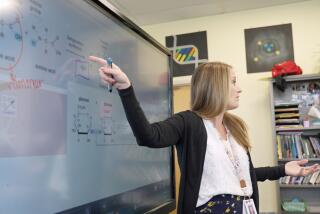Three Rs, Students’ Self-Image Top Educators’ List of Priorities
WASHINGTON — Teaching the three Rs--reading, ‘riting and ‘rithmetic--is still the most important goal for high school educators, according to a survey that also shows teachers increasingly are concerned about gangs and crowded classrooms.
“There has been a tremendous increase in concern about basic skills, and states are now testing like they never have before,” said Leonard O. Pellicer of the University of South Carolina, who compiled the study for the National Assn. of Secondary School Principals.
“In my own view, Americans, in general, feel the schools have not done a good enough job in basic skills to prepare (their children) to function as literate members of society,” Pellicer told a news conference.
1,544 Schools Represented
The report, titled “High School Leaders and Their Schools,” summarizes the organization’s 1987 survey of high school principals and assistant principals in 1,544 schools. It is a follow-up to similar surveys in 1965 and 1977.
The study indicated that the top three goals of school officials--teaching students basic skills, helping them develop positive self-images, and furthering intellectual inquiry and problem solving skills--remained the same as in the 1977 survey.
Teaching basic skills also was the top priority in 1965, but that year the second and third top objectives were, respectively, promoting development of moral and spiritual values, and promoting an understanding of the American system.
Today’s high school principals also see a greater need to prepare American youth “for a changing world”--a goal that was fourth in the latest survey, up from eighth in 1977.
The other goals identified in the new survey were, in order: promoting development of moral and spiritual values; providing career planning and training in special entry-level job skills; promoting understanding of the American value system; teaching skills needed in a technological society; teaching skills for family life; promoting physical fitness; and offering exposure to the fine arts.
When asked which of 27 conditions would have an impact on their schools in the next five years, almost half (49%) said gang activity would have a strong influence, followed by 39% who listed increases in enrollment and 37% who identified youth unemployment.
This finding was a surprise to Pellicer and association executive director Scott Thomson, who noted that gang activity listed well above drug (17%) and alcohol abuse (20%).
More to Read
Sign up for Essential California
The most important California stories and recommendations in your inbox every morning.
You may occasionally receive promotional content from the Los Angeles Times.










